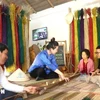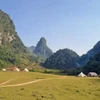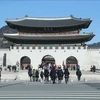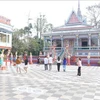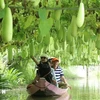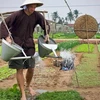In autumn, the fields of Mu Cang Chai turn varying shades of brilliant yellow and are filled with life as ethnic Mong farmers, wearing traditional attire, harvest the abundance of ripe rice and shoulder bags of the grain home over mountains and hills and across swinging suspension bridges.
Terraced fields, which rise and fall on hills and mountainsides as well as streams and rivers, are beautiful all year round. Visitors in March are treated to the sight of glittering ponds. Locals transplant rice seedlings from April to May. After that, all hills are covered by an everlasting green. Rice fields start to turn yellow with ripeness from early September.
"Harvest lasts from now to mid October. You will see the full beauty of terraced fields during that time," says Vang A Doi, chairman of the De Xu Phinh Commune People's Committee.
Terraced rice fields are visible from virtually everywhere in the district as they expand over 2,200ha, including 500ha in Che Cu Nha, La Pan Tan and De Xu Phinh communes. The terraced fields in these villages were recognised as a national heritage in 2007 by the Ministry of Culture, Sports and Tourism.
A trek through these villages offers a fabulous view inside the lives of the Mong people. Young boys are often seen joyfully playing on the roadside. In the distance, huts used to provide cover as farmers watch over their harvest dot the vista.
From Trong Tong Hamlet in La Pan Tan, terraces pour onto each other from above like yellow stairs calling people to heaven.
"As I think about the wonder of Mu Cang Chai, I find it hard to restrain my happiness as I take in the beauty before my eyes. In fact, this scene has inspired me to love life and labour. I love my country more because of the simple things it offers," says 20-year-old Bui Xuan Giang, an adventurous traveller.
Rice fields are not only a source of food and income for the Mong; they are an intrinsic part of their culture and of Mu Cang Chai, which is itself a quiet district on the bank of the Nam River.
"If any one asks me where I plan to go this autumn, I will reply without hesitation that I plan on visiting Mu Cang Chai, a district in Yen Bai Province, some 300km north of Hanoi," says Giang.
To reach Mu Cang Chai from Hanoi, you should follow the beautiful route of Road 32. Do not forget to stop at Tu Le Town in Van Chan District on harvest days to enjoy the outstanding flavour of sticky rice with chicken. In this town, local people harvest unripe rice to make green rice flakes which have the aromatic flavour that speaks of the beginning of autumn.
At this time, some of the rice fields scattered in the valley are turning a dark yellow which brings a sweet-scented ambience throughout the vast valley.
After leaving Tu Le, you will follow the Khau Pha mountain pass to travel the 27km between Van Chan and Mu Cang Chai. The name of the mountain pass literally means "sky's horn".
In the morning, the pass is typically hidden in a thick fog, making it impossible to see more than two metres in front of you.
"Sometimes, I have to close my eyes because of the curves. However, when I reach the summit, where cool breezes blow throughout the year, I have a sense that I've reached the gates of heaven and am standing on a cloud. In fact, when I stand at the top of Khau Pha pass, I can barely believe my eyes. Off in the distance, I see rooftops peeking out among tree covered hills and yellow rice fields. The fluffy clouds swirling below me are like a beautiful props from a fairy tale," says Giang.
In addition to terraced fields, Mu Cang Chai was blessed with naturally beautiful flora and fauna and outstanding geographic features, including vast mountain ranges with high peaks which have protected the people for ages, says Doi.
With forest area covering 80,000ha, researchers have found 22 reptile species, 127 bird species and 53 animal species, notably 200 individual black lemurs. There are animal reserves in Mu Cang Chai's Che Tao, De Xu Phinh and Pung Luong hamlets.
"I used to think that Mu Cang Chai was an isolated and desolate land with ethnic people living silently near the base of the mountain. However, my mind changed when I finally had the change to visit," says Giang.
Giang recommends a stop at the Giang stream in Van Chan for a soak in the jacuzzi to relax after a long day of adventure. You can also buy some aromatic San Tuyet tea to take home as a gift for family and friends at home./.
Terraced fields, which rise and fall on hills and mountainsides as well as streams and rivers, are beautiful all year round. Visitors in March are treated to the sight of glittering ponds. Locals transplant rice seedlings from April to May. After that, all hills are covered by an everlasting green. Rice fields start to turn yellow with ripeness from early September.
"Harvest lasts from now to mid October. You will see the full beauty of terraced fields during that time," says Vang A Doi, chairman of the De Xu Phinh Commune People's Committee.
Terraced rice fields are visible from virtually everywhere in the district as they expand over 2,200ha, including 500ha in Che Cu Nha, La Pan Tan and De Xu Phinh communes. The terraced fields in these villages were recognised as a national heritage in 2007 by the Ministry of Culture, Sports and Tourism.
A trek through these villages offers a fabulous view inside the lives of the Mong people. Young boys are often seen joyfully playing on the roadside. In the distance, huts used to provide cover as farmers watch over their harvest dot the vista.
From Trong Tong Hamlet in La Pan Tan, terraces pour onto each other from above like yellow stairs calling people to heaven.
"As I think about the wonder of Mu Cang Chai, I find it hard to restrain my happiness as I take in the beauty before my eyes. In fact, this scene has inspired me to love life and labour. I love my country more because of the simple things it offers," says 20-year-old Bui Xuan Giang, an adventurous traveller.
Rice fields are not only a source of food and income for the Mong; they are an intrinsic part of their culture and of Mu Cang Chai, which is itself a quiet district on the bank of the Nam River.
"If any one asks me where I plan to go this autumn, I will reply without hesitation that I plan on visiting Mu Cang Chai, a district in Yen Bai Province, some 300km north of Hanoi," says Giang.
To reach Mu Cang Chai from Hanoi, you should follow the beautiful route of Road 32. Do not forget to stop at Tu Le Town in Van Chan District on harvest days to enjoy the outstanding flavour of sticky rice with chicken. In this town, local people harvest unripe rice to make green rice flakes which have the aromatic flavour that speaks of the beginning of autumn.
At this time, some of the rice fields scattered in the valley are turning a dark yellow which brings a sweet-scented ambience throughout the vast valley.
After leaving Tu Le, you will follow the Khau Pha mountain pass to travel the 27km between Van Chan and Mu Cang Chai. The name of the mountain pass literally means "sky's horn".
In the morning, the pass is typically hidden in a thick fog, making it impossible to see more than two metres in front of you.
"Sometimes, I have to close my eyes because of the curves. However, when I reach the summit, where cool breezes blow throughout the year, I have a sense that I've reached the gates of heaven and am standing on a cloud. In fact, when I stand at the top of Khau Pha pass, I can barely believe my eyes. Off in the distance, I see rooftops peeking out among tree covered hills and yellow rice fields. The fluffy clouds swirling below me are like a beautiful props from a fairy tale," says Giang.
In addition to terraced fields, Mu Cang Chai was blessed with naturally beautiful flora and fauna and outstanding geographic features, including vast mountain ranges with high peaks which have protected the people for ages, says Doi.
With forest area covering 80,000ha, researchers have found 22 reptile species, 127 bird species and 53 animal species, notably 200 individual black lemurs. There are animal reserves in Mu Cang Chai's Che Tao, De Xu Phinh and Pung Luong hamlets.
"I used to think that Mu Cang Chai was an isolated and desolate land with ethnic people living silently near the base of the mountain. However, my mind changed when I finally had the change to visit," says Giang.
Giang recommends a stop at the Giang stream in Van Chan for a soak in the jacuzzi to relax after a long day of adventure. You can also buy some aromatic San Tuyet tea to take home as a gift for family and friends at home./.

